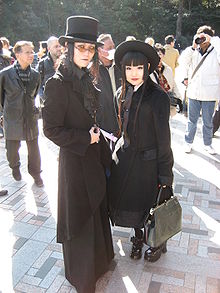- Neo-Victorian
-
Neo-Victorian is an aesthetic movement which amalgamates Victorian and Edwardian aesthetic sensibilities with modern principles and technologies. A large number of magazines and websites are devoted to Neo-Victorian ideas in dress, family life, interior decoration, morals, and other topics.
In September 2007, Exeter University explored the phenomenon in a major international conference titled Neo-Victorianism: The Politics and Aesthetics of Appropriation. Academic studies include Neo-Victorianism: The Victorians in the Twenty-First Century, 1999–2009.[1]
Contents
In arts and crafts
Examples of crafts made in this style would include push-button cordless telephones made to look like antique wall-mounted phones, CD players resembling old time radios, Victorianesque furniture, and Victorian era-style clothing.
In neo-romantic and fantasy art one can often see the elements of Victorian aesthetic values. There is also a strongly emerging genre of steampunk art. McDermott & McGough are a couple of contemporary artists whose work is all about a recreation of life in the nineteenth century: they only use the ultimate technology available, and since they are supposed to live anachronically, this means the use of earlier photographic processes, and maintaining the illusion of a life stuck in the ways of a forgotten era.[2]
In dress and behaviour
Many who have adopted Neo-Victorian style have also adopted Victorian behavioural affectations, seeking to imitate standards of Victorian conduct, pronunciation, interpersonal interaction. Some even go so far as to embrace certain Victorian habits such as shaving with straight razors, riding penny farthings, exchanging calling cards, and using fountain pens to write letters in florid prose sealed by wax. Gothic fashion incorporates Neo-Victorian style, but not behaviour.
Neo-Victorianism is embraced in, but also quite distinguished from, the Lolita, Aristocrat and Madam fashions popular in Japan, and which are becoming more noticeable in Europe.
Social conservatives
Neo-Victorian aesthetics are also popular in the US and United Kingdom among cultural conservatives and social conservatives.[3] Books such as The Benevolence of Manners: Recapturing the Lost Art of Gracious Victorian Living (ISBN 978-0060987459) by Linda S. Lichter call for a return to Victorian morality. The term Neo-Victorian is also commonly used in a derogatory way towards social conservatives.
It should be noted, however, that the actual cultural social attitudes and conventions of the Victorian era can be disputed.[4]
In popular culture and literature
Neo-Victorianism can also be seen in the growing steampunk genre of speculative fiction. Neo-Victorianism is also popular with, and in many ways prefigured by, those who are interested in Victoriana and historical reenactment.
Neo-Victorian details appear in The Diamond Age (1995) by Neal Stephenson, in which Neo-Victorians are one of the main groups in the novel.
See also
References
- ^ Ann Heilmann and Mark Llewellyn. Neo-Victorianism: The Victorians in the Twenty-First Century, 1999–2009, Palgrave MacMillan, 2010. ISBN 9780230241138
- ^ David Mc Dermott & McGough: A History of Photography (ISBN 978-0965728027)
- ^ Is This a "Victorian" Site?
- ^ Matthew Sweet, Inventing the Victorians
Further reading
- Chrisman, Sarah Waisted Curves: My Transformation Into A Victorian Lady 2010. Aegis & Owl Press
Categories:- Victorian era
- Aesthetics
- History of fashion
- Interior design
- Steampunk
- Technology in society
Wikimedia Foundation. 2010.

